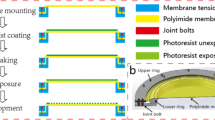Abstract
This study aims to produce a high fill factor micro lens with a specific tilt angle (asymmetric lens) and use it to enhancing the brightness of film with a light-emitting component. The asymmetric lens effect of the high fill factor micro lens can alter the light path and collect uniform lateral light as well as guide light to one side, allowing light-emitting components to be applied in uniform scenarios. Trace Pro optical simulation software was used to simulate the optimal gap between the mask and the photoresist. Then, photolithography was used to produce high fill factor asymmetric lens array. Snell’s Law was applied to control the offset angle of the asymmetric lens array. To obtain an asymmetric lens effect, the substrate was tilted a certain angle to achieve tilted exposure rather than traditional vertical exposure when performing proximity exposure. Therefore experiments can be carried out using different gaps between the optical masks and the photoresist. In addition, the asymmetric light control film optical microstructures can be produced without conventional thermal reflow procedures. The high fill factor asymmetrical micro lens array is successfully produced. The results of this study have significant potential applications in the reflective display micro-optical components industry.












Similar content being viewed by others
References
Chen CCA, Chen CM, Chen JR (2006) Tool path generation for diamond shaping of aspheric lens array. J Mater Process Technol 192–193:194–199
Cornelissen HJ, Neijzen JHM, Paulissen FAMA, Schlangen JM (1999) Reflectivedirect-view LCDs using polymer dispersed liquid crystal (PDLC) and dielectric reflectors. J Soc Inf Disp 7:37–41
Fukuda I, Sakai E, Kotani Y, Kitamura M, Yoon JB (1995) A new achromatic reflective STN-LCD with one polarizer and one retardation film. J Soc Inf Disp 3:83–87
Gan J, Wu L, Luan H, Bihari H, Chen RT (1999) Two-dimensional 45/spldeg/surface-normal micro coupler array for guided-wave optical clock distribution. IEEE Photonics Technol Lett 11:1452–1454
Hermans K, Hamidi SZ, Spoelstra AB, Bastiaansen CW, Mand Broer DJ (2008) Rapid, direct fabrication of antireflection-coated microlens arrays by photo embossing. Appl Opt 47:6512–6517
Hsu SS and Yang H (2010) High fill-factor microlens array fabrication using proximity printing with the microlens array mask, International Symposium on Robotics and Intelligent Sensors, March, 2010
Hung SY, Chao CK, Lin TH, Lin CP (2005) Applying ANN/GA algorithm to optimize the high fill-factor microlens array fabrication using UV proximity printing process. J Micromech Microeng 15:2389–2397
Jiang H, Yuan X, Yun Z, Chan YC, Lam YL (2001) Fabrication of microlens in photosensitive hybrid sol-gel films using a gray scale mask. Mater Sci Eng C 16:99–102
Ko FH, Chen JK, Chang CF (2006) Fabricating and characterizing oblique polymer structures by electron beam writing on resist-coated SiO2 wafers. Precis Eng 83:1132–1137
Kovalskiy A, Vlcek M, Jain H, Fiserova A, Waits CM, Dubey M (2006) Development of chalcogenide glass photoresists for gray scale lithography. J Non-Crystalline Solids 352:589–594
Lee SK, Kim MG, Jo KW, Lee JH (2007) Glass reflowed microlens array and its optical characteristics. 2007 IEEE/LEOS International Conference on Optical MEMS and Nanophotonics OMENS 75–76
Lee CL, Gu E, Dawson MD (2007b) Micro-cylindrical and micro-ring lenses in CVD diamond. Diam Relat Mater 16:944–948
Lin CP, Yang H, Chao CK (2003) A new microlens array fabrication method using UV proximity printing. J Micromech Microeng 13:748–757
Lin TH, Yang H, Chao CK (2006) Concave microlens array mold fabrication in photoresist using UV proximity printing. Microsyst Technol 12:82–90
Lin TW, Chen CF, Yang JJ and Liao YS (2008) A dual-directional light-control film with ahigh-sag and high-asymmetrical-shape microlens array fabricated by a UV imprinting process. J Micromech Microeng 18
Mikulskas I, Mickevicius J, Vaitkus J, Tomaunas R, Grigaliunas V, Kopustinska V (2002) Fabrication of photonic structures by means of interference lithography and reactive ion etching. Appl Surf Sci 186:599–603
Miura T, Yamada M, Aoki S, Kanazawa T, Urakawa Y, Watanabe H, Watanabe T (2003) Microminiaturized spherical single lens with numerical aperture of 0.9 for blue laser v diode. J Soc Inf Disp 43:4797–4798
Picard YN, Adams DP, Vasile MJ, Ritchey MB (2003) Focused ion beam-shaped microtools for ultra-precision machining of cylindrical components. Precis Eng 186:59–69
Satoh T, Ichimura A, Mikami O, Tomaru S, Hikita M, Uchida T (1998) Coupling of spot-size converted laser diode to polymeric waveguide with 45-degree micro reflection mirror for optical surface mount technology, IEMT/IMC Proceedings 114–117
Shyu RF, Yang H (2001) A promising thermal pressing used in fabricating microlens array. Int J Adv Manuf Technol 36:53–59
Tots K, Fujishiro K, Tanaka S, Esashi M (2006) Fabrication of three-dimensional microstructure using maskless gray-scale lithography. Sens Actuators A Phys 130:387–392
Yamada M, Miura T, Sakakibara H, Aoki S, Kanazawa T, Watanabe T (2003) A novel micro miniaturized a spherical lens with a high numerical aperture. J Soc Inf Disp 42:895–897
Yang H, Chao CK, Lin CP, Shen SC (2004) Micro-ball lens array modeling and fabrication using thermal reflow in two polymer layers. J Micromech Microeng 14:277–282
Yang H, Chao CK, Lin TH, Lin CP (2005) Fabrication of microlens array with raduated sags using UV proximity printing method. Microsyst Technol 12:82–90
Yang JJ, Liao YS, Chang CF (2007) Fabrication of long hexagonal micro-lens array by applying gray-scale lithography in micro-replication process. Optics Commun 270:433–440
Yu H, Li B, Zhang X (2006) Flexible fabrication of three-dimensional multi-layered. Sens Actuators 125:553–564
Acknowledgments
This work was supported by the National Science Council (series no. NSC102-2221-E-005-033) and Chung-Shan Institute of Science and Technology in Taiwan.
Author information
Authors and Affiliations
Corresponding author
Rights and permissions
About this article
Cite this article
Chang, TY., Hung, CH., Lian, ZJ. et al. Using proximity exposure to produce asymmetrical lens for light control films. Microsyst Technol 21, 1893–1901 (2015). https://doi.org/10.1007/s00542-014-2305-6
Received:
Accepted:
Published:
Issue Date:
DOI: https://doi.org/10.1007/s00542-014-2305-6



